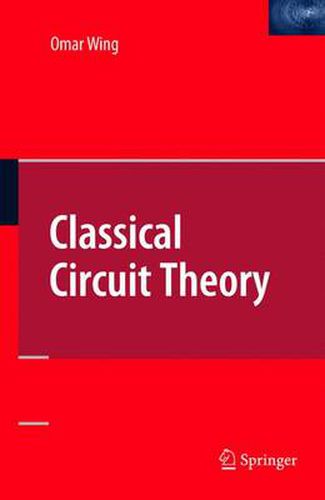Readings Newsletter
Become a Readings Member to make your shopping experience even easier.
Sign in or sign up for free!
You’re not far away from qualifying for FREE standard shipping within Australia
You’ve qualified for FREE standard shipping within Australia
The cart is loading…






This title is printed to order. This book may have been self-published. If so, we cannot guarantee the quality of the content. In the main most books will have gone through the editing process however some may not. We therefore suggest that you be aware of this before ordering this book. If in doubt check either the author or publisher’s details as we are unable to accept any returns unless they are faulty. Please contact us if you have any questions.
Classical circuit theory is a mathematical theory of linear, passive circuits, namely, circuits composed of resistors, capacitors and inductors. Like many a thing classical, it is old and enduring, structured and precise, simple and elegant. It is simple in that everything in it can be deduced from ?rst principles based on a few physical laws. It is enduring in that the things we can say about linear, passive circuits are universally true, unchanging. No matter how complex a circuit may be, as long as it consists of these three kinds of elements, its behavior must be as prescribed by the theory. The theory tells us what circuits can and cannot do. As expected of any good theory, classical circuit theory is also useful. Its ulti mate application is circuit design. The theory leads us to a design methodology that is systematic and precise. It is based on just two fundamental theorems: that the impedance function of a linear, passive circuit is a positive real function, and that the transfer function is a bounded real function, of a complex variable.
$9.00 standard shipping within Australia
FREE standard shipping within Australia for orders over $100.00
Express & International shipping calculated at checkout
This title is printed to order. This book may have been self-published. If so, we cannot guarantee the quality of the content. In the main most books will have gone through the editing process however some may not. We therefore suggest that you be aware of this before ordering this book. If in doubt check either the author or publisher’s details as we are unable to accept any returns unless they are faulty. Please contact us if you have any questions.
Classical circuit theory is a mathematical theory of linear, passive circuits, namely, circuits composed of resistors, capacitors and inductors. Like many a thing classical, it is old and enduring, structured and precise, simple and elegant. It is simple in that everything in it can be deduced from ?rst principles based on a few physical laws. It is enduring in that the things we can say about linear, passive circuits are universally true, unchanging. No matter how complex a circuit may be, as long as it consists of these three kinds of elements, its behavior must be as prescribed by the theory. The theory tells us what circuits can and cannot do. As expected of any good theory, classical circuit theory is also useful. Its ulti mate application is circuit design. The theory leads us to a design methodology that is systematic and precise. It is based on just two fundamental theorems: that the impedance function of a linear, passive circuit is a positive real function, and that the transfer function is a bounded real function, of a complex variable.